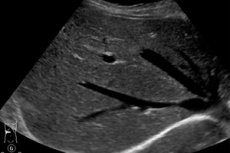Medical expert of the article
New publications
Additional methods of liver and gallbladder examination
Last reviewed: 06.07.2025

All iLive content is medically reviewed or fact checked to ensure as much factual accuracy as possible.
We have strict sourcing guidelines and only link to reputable media sites, academic research institutions and, whenever possible, medically peer reviewed studies. Note that the numbers in parentheses ([1], [2], etc.) are clickable links to these studies.
If you feel that any of our content is inaccurate, out-of-date, or otherwise questionable, please select it and press Ctrl + Enter.

A special place in the diagnostics of liver and biliary tract diseases belongs to the biochemical blood test. This primarily concerns the study of the content of a number of enzymes, among which are transaminases - AST (aspartic transaminase, glutamate oxalate transaminase, aspartate aminotransferase) and ALT (alanine transaminase, glutamate pyruvate transaminase, alanine aminotransferase), an increase in the level of which indicates damage (cytolysis) of hepatocytes.
Laboratory methods for diagnosing liver diseases
Blood test. A general blood test may reveal leukocytosis and an increased ESR, which is more common in acute cholecystitis and acute alcoholic hepatitis, leukopenia and thrombocytopenia along with an increased ESR (in chronic viral hepatitis ).
Of great clinical importance is the study of y-glutamyl transpeptidase (y-GTP), the activity of which increases in cholestasis and acute alcoholic liver damage, and alkaline phosphatase, which is detected in cholestasis and tumors; a decrease in serum cholinesterase activity usually indicates severe damage to hepatocytes.
The characteristics of dysproteinemia are assessed, in particular the presence of hypergammaglobulinemia. The severity of liver failure is judged by the degree of decrease in the content of albumins (hypoalbuminemia), cholesterol and prothrombin. High cholesterol in the blood is detected with bile retention ( cholestasis ). In addition to a decrease in albumin content, it is important to study the content of other protein fractions, carried out using electrophoresis and immunoelectrophoresis, and total blood protein. In some liver diseases, an increased level of the latter is noted (hyperproteinemia), which is often combined with hypergammaglobulinemia. Determination of the content of certain trace elements in the blood, primarily copper and iron, is of diagnostic importance. An increase in this indicator can lead to liver damage. High copper levels are often combined with low ceruloplasmin levels, which is usually genetically determined and is very typical of Wilson-Konovalov disease.
Immunological methods. A number of immunological methods are used, mostly to detect non-specific changes (determination of immunoglobulins of different classes, complement, circulating immune complexes), but in some cases they also have some specific significance (high levels of IgA in the blood serum are often found in alcoholic liver damage, detection of high titers of antinuclear antibodies and antibodies to smooth muscles is characteristic of autoimmune hepatitis, antimitochondrial antibodies - for primary biliary cirrhosis of the liver).
Recently, methods have been widely used that allow detecting both infection with hepatitis A, B, C viruses, delta particles, and the replication stage of these viruses, especially with respect to hepatitis B (HBV) and hepatitis C (HCV) viruses, for example, the replication stage of HBV is determined by identifying markers such as HBV DNA, DNA polymerase, HBe antigen, HBc antibodies associated with IgM. These results are important not only for clarifying the etiology of liver disease, but also for deciding on the appointment of antiviral treatment.
Instrumental diagnostic methods
Endoscopic methods. Among these methods, esophagogastroduodenoscopy is primarily used, which allows for the detection of changes in the veins, esophagus, gastric mucosa (which is typical for portal hypertension syndrome), erosive esophagitis (often observed in alcoholic liver disease).
Radiological methods are used (especially for the detection of varicose veins of the esophagus - an important sign of increased pressure in the portal vein system); computed tomography, radionuclide methods and ultrasound examination (primarily for the detection of focal, as well as diffuse changes in the parenchyma in cirrhosis and fatty liver disease), which is supplemented by liver angiography.
Special methods of liver examination
Methods |
Indications |
Focal lesions (tumors, metastases, cysts, abscesses). Diffuse lesions (late stage cirrhosis). |
|
Focal lesions. Liver cirrhosis, liver steatosis. Study of the details of the anatomical structure (diagnosis of cholestasis, portal hypertension, ascites, splenomegaly). Control during liver biopsy, puncture of focal lesions. |
|
Study of the details of the anatomical structure, vascular system, biliary tree (diagnosis of cholelithiasis, abscesses, cysts, tumor metastases, hemangiomas, adenomas). Control during puncture of the pathological focus. |
Laparoscopy and biopsy. Of particular importance in the diagnosis of liver and biliary tract diseases are laparoscopy and targeted liver biopsy (more often, "blind" percutaneous liver biopsy is used).
Indications for liver biopsy
- Hepatomegaly of unspecified genesis.
- Persistent increase in the content of ACT, AJIT, and y-GT.
- Detection of hepatitis virus markers.
- Drug-induced liver damage.
- Alcoholic liver disease.
- Unexplained hepatomegaly and abnormal liver function tests.
- Storage diseases.
- Infectious and systemic diseases.
- Examination of relatives of patients with hereditary liver diseases.
- Focal lesions.
Cholecystography. Recently, in addition to X-ray contrast cholecystography (oral or intravenous), ascending (retrograde) administration of a contrast agent through the mouth of the common bile duct (endoscopic retrograde cholangiopancreatography - ERCP) has been used, which allows one to establish the location and cause of biliary hypertension, in particular, narrowing (stricture) of the bile ducts.

